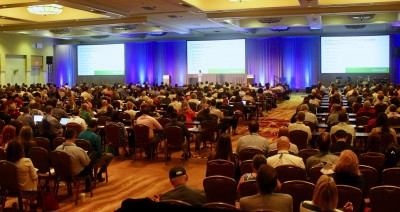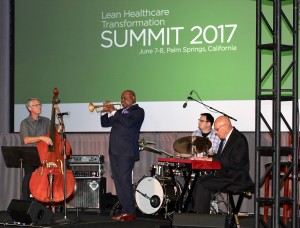Insights from the 2017 Lean Healthcare Transformation Summit
Learn, Share and Connect at Its Best!
 Each year the Lean Healthcare Transformation Summit offers attendees a chance to share their lean successes and challenges with each other – and learn about new trends that may help them succeed on their journey. The 2017 Summit wrapped up on June 8 and provided hours of fruitful learning and collaboration.
Each year the Lean Healthcare Transformation Summit offers attendees a chance to share their lean successes and challenges with each other – and learn about new trends that may help them succeed on their journey. The 2017 Summit wrapped up on June 8 and provided hours of fruitful learning and collaboration.
For those who were unable to attend the Summit (and even for those who were there), we’ve summarized several important trends that were addressed by our keynote presenters and at various learning sessions.
Partner with the C-Suite
It’s no secret that garnering support from your organization’s C-level executives is important to ensure the success of a lean transformation. But just how do you get that support?
Timothy Pehrson, CEO North Region and vice president of Continuous Improvement at Intermountain Healthcare, believes when you have the support of your CEO and COO your plans will get the traction they need. He suggests talking about your improvement plans with executives in terms they will understand.
“Use the power of context to get your CEO’s attention,” said Pehrson. “‘Journey’ becomes ‘enterprise operating or management systems.’ ‘Model Cells’ become ‘everyone is involved and engaged in improvement.’ The words do matter so choose them wisely.”
John Toussaint, MD and CEO of Catalysis agreed. “When speaking with CEOs, its important to look in the mirror. Recognize that each executive needs something slightly different from you and strive to meet their information needs.”
Kathleen Krusie, president, North Region at Community Health Network, also shared her views on being a lean leader. She said she always felt she was open to new ideas and solutions to solve problems, but continued to hold on to a “the buck stops here” mentality.
“I eventually learned that I’m often the least qualified person to solve problems,” said Krusie. “Putting the people who do the work together and getting them to identify the solution that creates customer value always produces the best result. And CEOs should know giving up control creates a more engaged and excited staff.”
Maximize Innovative Thinking
Innovation comes from rethinking, not from simply making incremental improvements. Ted Toussaint and Sarah Steinberg, both served as Innovation Engineers at Atrius Health, which created its own Innovation Center designed to assist in transforming care to improve patients’ lives.
“Atrius used innovative thinking to shift the organization from a volume to value health system,” said Steinberg. “Organizations have two paths they can consider to move forward: change today’s care model, or build new care models. Innovative thinking will help transform how care is delivered with a focus on the right care at the right time.”
Matthew May, author of “Winning the Brain Game,” kicked off the Summit’s CEO Panel. Among May’s thought-provoking remarks, he said, “The system bats last every time. If you put a good system together, you help to ensure your organization’s success.”
According to May, a Strategic Innovation System is a repeatable system of work that guides creative concepts, from inception, to closely align with strategic goals.
CEO Forum panelists, Chip Davis, Sibley Memorial Hospital, Mary Kingston, Providence Little Company of Mary; and Gary Weinstein, Washington Health System, all agreed. While their organizations each incorporate different strategies in how innovation is applied and used, they all have incorporated innovation into their health systems that correlate to their lean initiatives.
Practice Lean Every Day
John Shook, CEO of the Lean Enterprise Institute, closed out the Summit with a poignant reminder about lean transformation. In his keynote presentation, Shook said, “Any person in any job can apply personal lean thinking to their spheres of influence every day. Simply saying you don’t have the ‘right’ leader or the ‘right’ team is just an excuse not to apply lean.”
All activities are learning activities. Whether it’s standardized work, kaizen at the individual level, system kaizen at the managerial level, or fundamental strategic decisions at the corporate level. The work of lean starts with each individual.
 One additional way to practice lean each day is to establish and adhere to a routine that works for you. Creating a personal routine will position you for greater success in all you do, according to keynote speaker Terrell Stafford, director of Jazz Studies at Temple University. Stafford recommends personal routines that include three main components:
One additional way to practice lean each day is to establish and adhere to a routine that works for you. Creating a personal routine will position you for greater success in all you do, according to keynote speaker Terrell Stafford, director of Jazz Studies at Temple University. Stafford recommends personal routines that include three main components:
- Maintenance Routine for health and wellness.
- Growth Routine to challenge you professionally.
- Exploration Routine to study and analyze how others work and apply the best strategies to your work and life.
Stafford suggests establishing a work/life routine and adhering to it with dedication – spending designated time on each component of the routine on a daily basis. Applying this strategy for 30 years has helped Stafford throughout his life. Hard to argue with a Grammy award-winning musician.
In our effort to learn, share and connect, Catalysis will continue to create valuable content for you that includes new thinking gleaned from speakers and conversations we shared with attendees at the 2017 Summit. Stay tuned.








Leave a Reply